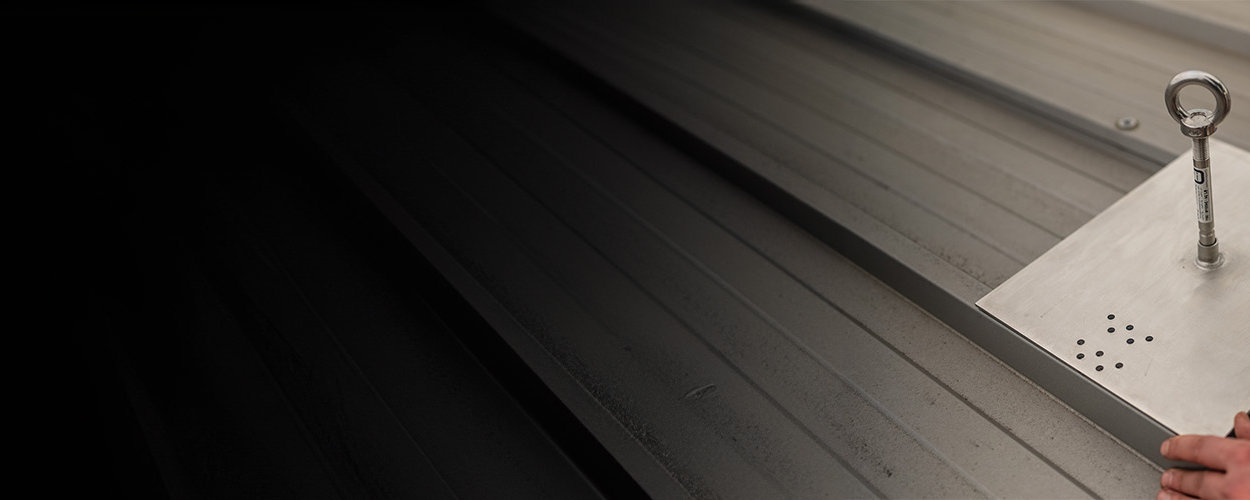– What you need to know
Questions frequently arise on the subject of fall protection. Many of them are easy to answer - some involve external rules and regulations and are therefore somewhat more difficult to answer. We have summarised the most frequently asked questions for you:
What is fall protection
The meaning of the term is actually already in the root of the word. A fall arrest system protects people from falling. Fall protection is a device that is suitable for preventing a fall in hazardous areas (primary fall protection) or catching people/material in the event of a fall (secondary fall protection). Dangerous areas do not always have to be high roofs. In some cases, windows, balconies and other areas that have fall edges and where the fall height can lead to injuries are also secured.
In the technical rules for workplaces (ASR), fall protection is defined as ‘an inevitably effective device that prevents a fall even without the conscious co-operation of employees, e.g. a barrier [...] or cover’
Who needs fall protection?
Insbesondere Arbeitsplätze die höhergelegen sind, müssen zum Schutz der Arbeitskräfte mit Absturzsicherungen versehen werden. Hier sind besonders Arbeitsplätze auf Flachdächern zu nennen. Arbeiter die zur Montage (beispielsweise auf dem Bau) oder zu Wartungsarbeiten auf Dachflächen arbeiten, werden über die persönliche Schutzausrüstung (z.B. Seil und Gurt) und Anschlageinrichtungen oder Seilsicherungssysteme gesichert.
When is fall protection required
This question is difficult to answer in general terms, as various regulations (DGUV, ASR) may be relevant in Germany. The clearest regulation (valid for construction work) can be found here in Annex 5.2 Para.2 ArbStättV:
(2) Protective devices to prevent employees from falling at workplaces and traffic routes on construction sites must be provided:
1.irrespective of the fall height at
a) workplaces on and above water or on and above other solid or liquid substances in which it is possible to sink,
b)traffic routes above water or other solid or liquid substances in which one can sink,
2. if the fall height is more than 1 metre at wall openings, exposed staircases and landings, and
3. at a fall height of more than 2 metres at all other workplaces.
As a rule, fall protection devices are therefore required from a fall height of 2 metres. Fall protection devices on roofs are usually required from a fall height of 3 metres.
However, the fall heights are not fixed and can vary individually, also taking into account the following factors.
- How high is the fall height (height difference)?
- What is the distance to the edge of the fall?
- What is the nature of the surface on which the fall protection system is to be installed?
- What is the nature of the surface below?
- Are groups of people or individuals to be protected?
It is therefore important that you plan your fall protection system carefully in advance. We are happy to support you with this!
Why fall protection?
As already explained, there are regulations that govern the installation of fall protection devices on roofs. However, fall protection devices are also useful even outside of regulations. It does not always have to be the worst-case scenario (a fall) for an anchor point and simple protective equipment to pay off, for example.
Workers who suffer from a fear of heights, do not feel comfortable at great heights or are in great need of safety are significantly relieved mentally if they know that they are ‘safe’ even in the event of a fall. With suitable fall protection, workers at height can concentrate fully on their job, which is good for the quality of the work performed.
The question of ‘why’ is no longer necessary if a fall occurs and the fall protection system allows the rope access technician to escape without any major injuries. Also remember that regular maintenance and inspection of the fall protection elements (PPE, anchorage device, lanyard, safety harness) must be carried out so that nothing stands in the way of safe use.
What are the quality features of fall protection?
- In Germany, anchorage devices (AE) require a building authority approval issued by the DIBt (German Institute for Building Technology) in order to be used. This ensures that safety-relevant guidelines are complied with.
- There are DIN standards for PPE components that ensure minimum quality. These include DIN EN354:2010 and DIN EN 795:1996 in particular
Why is good planning important?
Depending on the area of application and purpose of the fall protection system, detailed planning lays the foundation for comprehensive safety. Both anchor points and lifeline systems have different properties that are better/worse suited for different purposes. Therefore, important questions must be clarified in advance in order to be able to decide on measures:
- Can collective protection be implemented, or must individual protection be used?
- Is individual protection designed as a restraint system or as a containment system?
- Are there factors that prevent the use of certain systems in principle?
- How extensive does the protection need to be?
Let our experts advise you on your planning and achieve the right level of security.
Primary or secondary fall protection?
Primary fall protection
Primary fall protection systems are systems such as guardrails (for flat roofs) or barrier posts, which are designed to have a preventative effect. These devices are designed to prevent people from getting close to the edge of the fall or from falling. These systems are usually categorised as collective protection.
Secondary fall protection
In contrast to primary fall protection systems, secondary fall protection systems are used to catch people or material in the event of a fall (e.g. fall from a roof). So-called anchorage devices are always used for secondary fall protection. These can include anchor points and lifeline systems on flat roofs and safety roof hooks on pitched roofs.
Secondary fall protection systems usually work in combination with PPE, which is why they are also categorised as individual protection.
